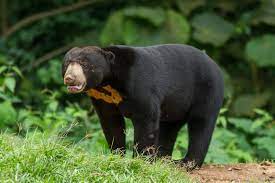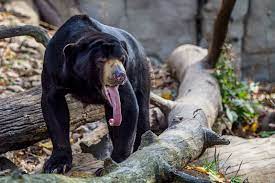The Mysteries of the Sun Bear Weight

Exploring the Ecology, Conservation, and Adaptations of the Elusive Sun Bear
In the plush rainforests of Southeast Asia, a fantastic creature quietly roams the dense foliage, often hidden from human eyes. The sun bear, acknowledged for its extraordinary chest patch and diminutive length, isn’t always the most effective subject of ecological study, but it is also a flagship species for conservation efforts. In this newsletter, we delve into the captivating world of sun bears, shedding light on their weight, ecological significance, and the demanding situations they face in the wild.
Meet the Sun Bear

The sun bear (Helarctos malayanus), additionally known as the “honey bear” due to its fondness for honeycombs, is the smallest species in the world of bears. These elusive creatures are spread across Southeast Asia, inhabiting tropical rainforests in Malaysia, Indonesia, Thailand, and Borneo. Sun bears are recognized for their specific look, offering sleek black fur and a patch, crescent-shaped patch of golden or white fur on their chest.
The Weight of a Sun Bear
Sun bears are small, but their weight can vary appreciably depending on factors that include age, intercourse, and available food sources. On average, adult solar bears commonly weigh between 60 and 145 pounds (27 and 66 kilograms). Males are generally larger than women, with grownup males weighing towards the higher end of this variety.
Sun Bear Weight: Nature’s Lightweight Wonder
The sun bear, recognized for its small length compared to different bear species, captivates us with its excellent adaptability. Weighing in at a mean of 60 to 145 pounds (27 to 65 kilograms), sun bears are real light-weight wonders within the animal kingdom world. Despite their small size, they may not be underestimated.
We explain how their notably small stature is an evolutionary gain, letting them navigate the dense rainforests of Southeast Asia with no trouble or precision problems. As we delve into the sun bear’s precise traits and lifestyle, we’ll find out that their lightweight nature performs an important function in their survival and their crucial role in their ecosystem, making them a true marvel of nature.
Weighing in on the Lightest Bear Species
We shed light on the charming world of the sun bear, often referred to as the ‘teddy bear of the jungle’ due to its petite stature. Among the eight bear species, the sun bear is the smallest, with bears normally weighing between 60 and 145 pounds (27 to 65 kilograms). While they may be the lightweights of the bear world, these charismatic creatures are truly superb in their own right.
Found predominantly within the dense rainforests of Southeast Asia, they’re master tree climbers, forging a completely unique niche in their habitat. Their small size and agility make them skilled foragers and permit them to access tough-to-reach food assets. We embark on a journey to apprehend the extremely good diversifications and characteristics that set the sun bear aside, highlighting the energy and versatility that come with these small bears.
The Mystery of Sun Bear Weight
We delve into the exciting realm of sun bears and their seemingly enigmatic weight. Sun bears, the smallest of the bear species, often leave humans astounded by their light-weight nature. Sun bears’ average weight, ranging from 60 to 145 pounds (27 to 65 kilograms), is a testament to their top-notch evolution in reaction to their difficult environment.
As we discover the evolutionary know-how at the foundation of their size and the benefits it brings, we discover how their lightweight build contributes to their agility, arboreal evolution, and unique nutritional selections. This piece aims to shed light on the profound connections among sun bear weight and their survival techniques, emphasizing that their strong point is an essential part of the difficult net of life inside the lush forests of Southeast Asia.
Sun Bear Body Mass: A Remarkable Feat of Evolution
Sun Bear Body Mass: A Remarkable Feat of Evolution uncovers the excellent adaptability of the sun bear, in particular in relation to their body mass. These enigmatic bears, weighing between 60 and 145 pounds (27 and 65 kilograms) in common, exemplify the marvels of evolution. Their compact size is manufactured from nature’s ingenuity, permitting them to thrive inside the dense forests of Southeast Asia.
The sun bear’s weight is a notable feat of evolution, letting them traverse the treetops with agility, attain hidden food assets, and navigate their complex rainforest habitat easily. This article explores the delicate balance between sun bear weight and survival strategies, revealing the sun bear’s fantastic evolutionary adventure and emphasizing their essential position in maintaining the health and biodiversity of their specific ecosystem.
Sun Bears’ Weight in the Wild: Surviving as a Lightweight Predator
“Sun Bears’ Weight in the Wild: Surviving as a Lightweight Predator” unravels the secrets and techniques of one of the animal kingdom’s most fascinating adaptations. Sun bears, with their common weight ranging from 60 to 145 pounds (27 to 65 kilograms), encompass nature’s capacity for ingenuity. These diminutive but sturdy creatures have harnessed their lightweight construct to perfection, letting them excel in the dense rainforests of Southeast Asia.
Their dexterity and agility enable them to navigate the treetops, forage for termites, and extract honey from bee nests with unexpected ease. We present how their slender bodies are a key to their success as predators in the wild. By illuminating their amazing hunting strategies, habitat options, and ecological position, we gain a deeper appreciation for the sun bear’s precise ecosystem within the natural world and its potential to live on and thrive as a light-weight predator in the tropical rainforest.
Ecological Significance
Despite their small size, sun bears play an important role in maintaining the health and stability of their rainforest habitats. Here’s how:

- Seed Dispersal: Sun bears are frugivores, which means they frequently feed on fruits. As they fight for dominance inside the rainforest, they inadvertently disperse seeds throughout the forest ground. This system contributes to the regeneration of diverse plant species and supports the fitness of ordinary surroundings.
- Insect Control: In addition, solar bears have a penchant for insects, consisting of termites and ants. By consuming these arthropods, sun bears help manipulate insect populations, preventing infestations that might damage the bushes and vegetation of their habitat.
- Nutrient Cycling: Sun bears play a role in nutrient cycling by eating and redistributing healthy nutrients to plants through their feces. This method aids in nutrient recycling within the surroundings, benefiting plant growth and woodland ecosystem.
Conservation Challenges
While sun bears are important for their ecosystems, they face numerous conservation challenges.
- Habitat Loss: The number one risk to sun bears is habitat loss because of deforestation, pushed by logging, agriculture, and infrastructure projects. As their wooded area houses cut back, solar bears are pushed into smaller and fragmented habitats.
- Illegal Trade: Sun bears are frequently targeted for illegal natural world trade. Their body parts, inclusive of paws and gall bladders, are sought after in traditional medicine and the uncommon pet trade.
- Human-Wildlife Conflict: Conflict between sun bears and human beings takes place when bears raid plants or houses in search of food. Retaliatory killings and capture exacerbate population declines.
Conservation Efforts

Efforts to protect sun bears and their tropical rainforest habitats are underway:
- Protected Areas: Establishing and keeping tropical rainforests and natural world reserves is essential for holding the sun bear population.
- Anti-Poaching Measures: Efforts to fight illegal hunting consist of accelerated regulation enforcement, tracking of natural world markets, and public recognition campaigns.
- Community Engagement: Involving nearby communities in conservation efforts can help reduce human-flora and fauna struggles and raise awareness of the importance of sun bears and their habitats.
Conclusion
The weight of a sun bear, while modest in scale, contains immense ecological importance in Southeast Asia’s rainforests. These awesome creatures are essential to the health and balance of their ecosystems, playing key roles in seed dispersal, insect control, and nutrient dispersal. However, the challenges they face, along with habitat loss and unlawful trade, threaten their survival. As conservation efforts continue, it’s our collective responsibility to guard those elusive creatures and the rich ecosystems they call home, ensuring that the weight of the sun endures and stays a cornerstone of Southeast Asia’s herbal heritage for generations to come.